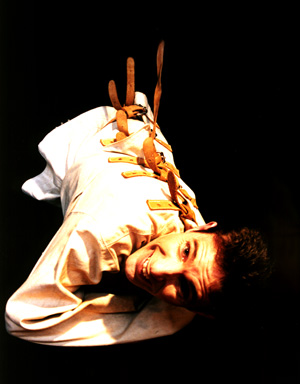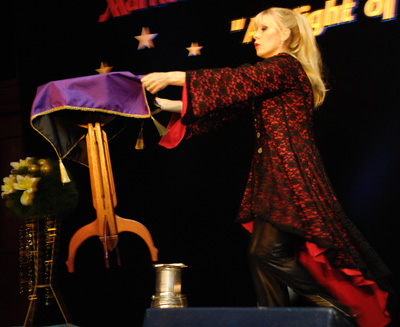
DAVID ADAMS reports…
They’re not your average couple. Well, she routinely saws her husband in half using a chainsaw, for a start.
Meet Tim Ellis, 45, and Sue-Anne Webster, 43, two of Australia’s most high profile performing magicians.
 |
|
JUST HANGING AROUND: Tim Ellis preparing to escape from his strait-jacket. |
Mr Ellis has been working in the industry for more than 30 years and his wife for more than 22. While their faces may be familiar to many thanks to their decades of work, not to mention Mr Ellis’ more than 80 TV appearances, what you may not know is that they are both committed Christians.
Mr Ellis, who grew up in Melbourne, first encountered magic when he was about 10-years-old and his grandfather gave him a magic set.
“I learnt all the different tricks in the magic set and then after I’d shown them to my family and friends a dozen times each, I had to learn more,” he recalls. “So I went to the local library, got all the books out and learned all those tricks. Then I went to the magic shop and bought tricks from there and just kept going and going and going and haven’t stopped.”
Mr Ellis, who trained as a TV producer and editor, attracted much media attention in the Eighties and Nineties, performing stunts on national television which included escaping from strait jackets and from a padlocked wooden crate lowered into the Yarra River.
He became the first Australian to have won two awards at the World Championship of Magic – in 1991 when he won a special prize of the jury and a silver medal for the close up competition in 1994, owned Australia’s oldest magic shop – Bernard’s in Melbourne – for five years and, as well as performing around the world, has also been extensively involved in training other magicians and developing the industry in Australia.
For Ms Webster – the inaugural president of the Australian Institute of Magic – it wasn’t until her early 20s that she decided to embark on a career in the industry.
“I think as children a lot of us want to be magicians but those kinds of thoughts fade away as you get older,” she says. “I was always fascinated with magic but I couldn’t find a place to study back in the 1970s. It was a very male-dominated area and back then everything was very, very secret because there was no internet, so no-one could find magic very easily and the clubs weren’t necessarily open to having female magicians join or, if they did, they didn’t seem very friendly.
“So I pretty much found a magic teacher – I didn’t go out looking, I had an art teacher and discovered that he was also a magic teacher – and after I’d he’d shown me a trick or two, that was it, that was my career…”
It hasn’t always been an easy path for her, given the male-dominance of the industry. To this day, when she does shows with her husband, some people still assume she’s the assistant.
“When Sue-Anne goes off to do shows by herself, people say ‘Oh, you’re the magician’, but if there’s a male with her – even if it’s a roadie – they’ll start talking to the guy who’s carrying the stuff as though he’s the magician,” notes Mr Ellis. “It’s very frustrating for someone whose worked all their life to be a full-time magician.”
While Mr Ellis grew up in a Christian home – he describes his Christian walk as an “ongoing revelation”, Ms Webster only became a Christian after they were married – they had met in 1997 at a magic convention in Sydney – Tim had called her up on stage during his performance and they had hit it off, keeping in contact by phone until they were married 10 months later.
“I’ve only been a Christian now for almost eight years,” Ms Webster says. “(I)n fact, I was a practising New Age (follower) – I was into the tantric texts and Hinduism, the occult and all of that and I went to a spiritualist church.”
After marrying Mr Ellis, she started going with him to church – “I thought that was a very good thing for him to do but at the same time I was trying to prove that Christianity was just a whole heap of rubbish,” she says.
But before she launched into her crusade against Christianity, Ms Webster says she decided to try and find out a bit more about it.
“So I went to a course to try and find out a bit more about Christianity and understand it a bit more,” she recalls. “But it wasn’t until I picked up a pamphlet that a creation ministry had at our church -because I was right into science and evolution and things like that – and it really rocked me.”
She tried to read the Bible but couldn’t understand what it was saying.
 |
|
TAKING A TABLE FOR A RIDE: Sue-Anne Webster “levitates” a table during a performance. |
“(S)omeone had told me, in one of the courses, to ask God…so I looked at the words and I prayed with all my heart, right then and there, when I said ‘Please God, I really need to understand these words, I want to’, those words went right up into my soul. And I tell you what, that was the most incredible revelation: I never felt so moved, I was shaking, I was crying and I was giving my life to Him right then and there. One second before that, I was a Jesus hater and second after I gave my life to him. And since then it’s just been one huge learning, exponential curve…”
To some, working as a magician may seem at odds with being a Christian (on some occasions they’ll call themselves illusionists instead of magicians, a term which some may find more confronting) but Mr Ellis and Ms Webster – who attend a small church in Melbourne – both say that their tricks – which are performed by sleight-of-hand – are nothing to do with the occult-based practices of magicians mentioned in the Bible.
“Today the term magician is usually used to refer to an entertainer,” Ms Webster explains. “Back then…a magician was a person who was into the occult…When you call yourself a magician now, you’re generally an entertainer who’s willing to tell people it was just a trick, sleight-of-hand.”
Ms Webster adds the couple’s training means they’re also able to show people some of the tricks used by those who might try to pass themselves off as psychics, mind readers or mediums.
“I can show people how strong a trick can be and how much it can move people and show them that they need to be careful because there’s a lot of deception out there,” he says. “And if we don’t have our eyes wide open, we can be taken down that road.”
While the couple do work together on occasions, they also have solo shows – Mr Ellis describes Ms Webster’s material as more theatrical and fantasy-based than his own – at some of her performances, for example, she dresses up as the genie Jeannie from the Sixties TV sitcom I Dream of Jeannie (in fact, so much does she look like Jeannie – who was played by Barbara Eden, that Ms Webster is now the official lookalike for the US-based I Dream Of Jeanniewebsite).
Being a magician can lead to some odd moments – Ms Webster talks about taking the chainsaw in for repairs and having to explain what she uses it for or getting some strange looks when she drops off a strait-jacket at a leatherworkers – and also some dangerous ones – in fact, other magicians who know the secret behind the trick in which Ms Webster saws her husband in half with a chainsaw have told them they won’t do it because it is too dangerous.
“It does use a real chainsaw and it does have no safety; there is no safety precautions,” says Mr Ellis. “It is genuinely the most dangerous trick we do.”
On the subject of danger, Mr Ellis made newspaper headlines earlier this year in Melbourne when a story began circulating that something had gone “horribly wrong” during the performance of a trick involving a broken beer bottle and even suggested that people attending the performance had been made to sign a confidentiality agreement before they left.
“The story was completely fictitious but very entertaining…” says Mr Ellis. “But it has reinforced the drama of the trick.”
As to what’s the key to a good magic trick?
“What you’ve got to do is you’ve got to take away all of the possible explanations; you’ve got to know what the audience is going to be thinking and counter it. It’s like a sword fight, to some extent…It’s really anticipating everything and knocking it on the head before they can think of it.” |
“The key to magic is that there is no magic if no-one’s watching,” explains Mr Ellis. “The magic actually takes place in the person’s mind. I mean, if someone’s flying around on stage and the audience is sitting there and going ‘Oh, yeah, I know how this is done, he’s got wires and magnets and trapdoors or something like that’, then the magic is not happening in that person’s mind, no matter what you do.
“What you’ve got to do is you’ve got to take away all of the possible explanations; you’ve got to know what the audience is going to be thinking and counter it. It’s like a sword fight, to some extent…It’s really anticipating everything and knocking it on the head before they can think of it. And if you do achieve that, you’re going to have people coming up afterwards, saying ‘I have absolutely no idea (how it’s done’). ”
In illustration of his point, Mr Ellis says that one trick which helped to make their international reputation a few years ago – called soda resurrection – involves him opening and pouring out the can of drink before crushing it after which the can then visibly uncrushes, refills and reseals itself.
“When we went around America doing lecture tours and performing that trick, magicians were coming up to us afterwards and saying ‘I don’t want to know how that’s done because I got to have the feeling of real magic again, it’s a feeling I haven’t had for years’,” he says. “Because, of course, they know all the secrets. But when they saw something that really fooled them and really got to their core…it gave them that feeling again that they had when they first saw magic.”
~ www.magicunlimited.com
~ www.sueannewebster.com
~ www.australianinstituteofmagic.org





